-
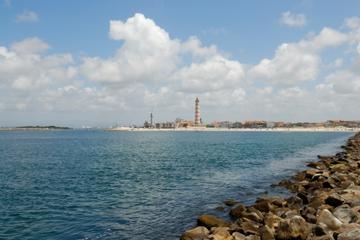 Aveiro
Aveiro In Roman times, Aveiro was known as Aviarium, which in Latin means “gathering of birds” due to the large number of birds inhabiting the city’s lagoon area. Today, Aveiro is known for being one of the largest metropolitan areas in Portugal (when associated with nearby Ílhavo). It’s also know
Aveiro
Aveiro In Roman times, Aveiro was known as Aviarium, which in Latin means “gathering of birds” due to the large number of birds inhabiting the city’s lagoon area. Today, Aveiro is known for being one of the largest metropolitan areas in Portugal (when associated with nearby Ílhavo). It’s also know
-
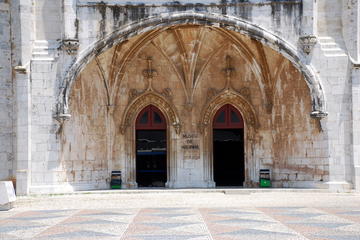 Maritime Museum (Museu de Marinha)
Maritime Museum (Museu de Marinha) Lisbon has a long and proud maritime history. This museum focuses on that long naval history with model ships, nautical instruments and uniforms. Among the armadas of model boats, this museum has gems such as Vasco da Gamas portable wooden altar and the rich, pol
Maritime Museum (Museu de Marinha)
Maritime Museum (Museu de Marinha) Lisbon has a long and proud maritime history. This museum focuses on that long naval history with model ships, nautical instruments and uniforms. Among the armadas of model boats, this museum has gems such as Vasco da Gamas portable wooden altar and the rich, pol
-
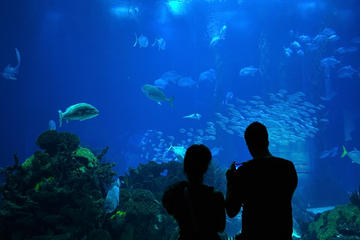 Oceanário de Lisboa
Oceanário de Lisboa The modern beating heart of Lisbon now lies in the Parque das Nacoes, the brainchild of Spanish architect Santiago Calatrava that was constructed for the 100th World Expo in 1998. Calatrava’s reshaping of the city’s formerly dilapidated waterfront into something resembling a mi
Oceanário de Lisboa
Oceanário de Lisboa The modern beating heart of Lisbon now lies in the Parque das Nacoes, the brainchild of Spanish architect Santiago Calatrava that was constructed for the 100th World Expo in 1998. Calatrava’s reshaping of the city’s formerly dilapidated waterfront into something resembling a mi
-
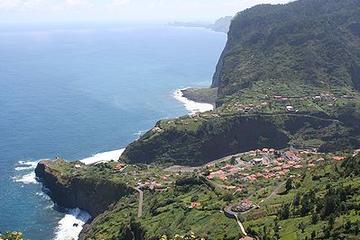 Santana
Santana Santana’s brightly colored A-frame houses, built in a traditional style with natural stone and thatched roofs, make this mountain destination worth the trip any time of year. The rolling wheat and rye fields, dotted with these triangular bungalows, are famous and distinctive sights. Travel
Santana
Santana Santana’s brightly colored A-frame houses, built in a traditional style with natural stone and thatched roofs, make this mountain destination worth the trip any time of year. The rolling wheat and rye fields, dotted with these triangular bungalows, are famous and distinctive sights. Travel
-
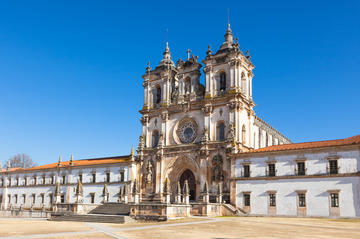 Alcobaça
Alcobaça Alcobaça is a pleasant town with a jumble of medieval and modern architecture and a largely pedestrianized center, but its main attraction is undoubtedly Portugal’s first monastery, founded here by the country’s first king, Alfonso Henriques, in 1153. Today the magical Cistercian monaster
Alcobaça
Alcobaça Alcobaça is a pleasant town with a jumble of medieval and modern architecture and a largely pedestrianized center, but its main attraction is undoubtedly Portugal’s first monastery, founded here by the country’s first king, Alfonso Henriques, in 1153. Today the magical Cistercian monaster
-
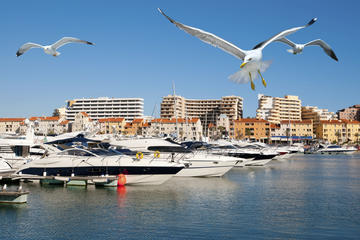 Vilamoura
Vilamoura Just 29 km (18 miles) north-west of Faro airport, Vilamoura sits on the Algarve’s Atlantic shoreline and is the region’s classiest purpose-built leisure resort. The town and its four international-level golf courses are a destination for golfers and sailors and the location of world-clas
Vilamoura
Vilamoura Just 29 km (18 miles) north-west of Faro airport, Vilamoura sits on the Algarve’s Atlantic shoreline and is the region’s classiest purpose-built leisure resort. The town and its four international-level golf courses are a destination for golfers and sailors and the location of world-clas
-
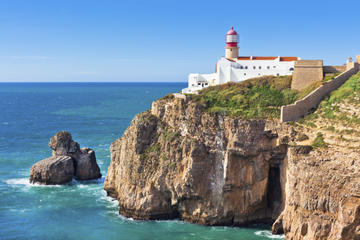 Sagres
Sagres Twenty-one miles west of Lagos, the whitewashed village of Sagres is popular with families looking for a laidback holiday spot near the Algarve’s famous beaches. Backpackers, surfers, and divers also come to Sagres to holiday. Most of the action takes place around the town square, where the
Sagres
Sagres Twenty-one miles west of Lagos, the whitewashed village of Sagres is popular with families looking for a laidback holiday spot near the Algarve’s famous beaches. Backpackers, surfers, and divers also come to Sagres to holiday. Most of the action takes place around the town square, where the
-
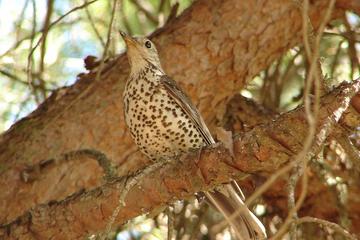 Ria Formosa Natural Park
Ria Formosa Natural Park Like Porto’s Parque Nacional da Peneda-Gerês, the Parque Natural da Ria Formosa is a Portuguese national treasure created for the preservation of the the Algarve’s unique marshland and its flora and fauna. It encompasses a large lagoon area hugging almost 60 km (37 mi) of
Ria Formosa Natural Park
Ria Formosa Natural Park Like Porto’s Parque Nacional da Peneda-Gerês, the Parque Natural da Ria Formosa is a Portuguese national treasure created for the preservation of the the Algarve’s unique marshland and its flora and fauna. It encompasses a large lagoon area hugging almost 60 km (37 mi) of
-
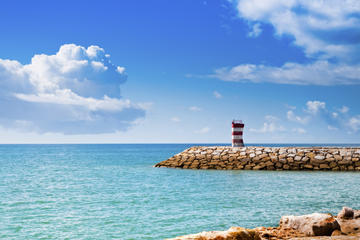 Quarteira
Quarteira With roots going back to Roman times, Quarteira was for many years a backwater fishing village, but today it is a buzzing seaside resort with the restaurant-lined promenade of Avenida Infante de Sagres backing the Atlantic Ocean. Primarily a family resort and very popular with Portuguese
Quarteira
Quarteira With roots going back to Roman times, Quarteira was for many years a backwater fishing village, but today it is a buzzing seaside resort with the restaurant-lined promenade of Avenida Infante de Sagres backing the Atlantic Ocean. Primarily a family resort and very popular with Portuguese
-
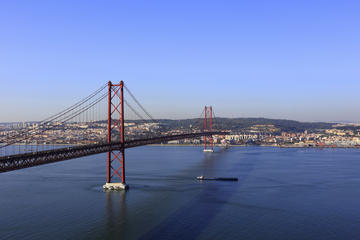 25th of April Bridge
25th of April Bridge This massive suspension bridge is an icon of Lisbon, connecting the city to the Almada area over the narrowest section of the River Tagus. Its color, size and structure draw close comparison to the Golden Gate Bridge of San Francisco, California, but the bridge was actually mo
25th of April Bridge
25th of April Bridge This massive suspension bridge is an icon of Lisbon, connecting the city to the Almada area over the narrowest section of the River Tagus. Its color, size and structure draw close comparison to the Golden Gate Bridge of San Francisco, California, but the bridge was actually mo
-
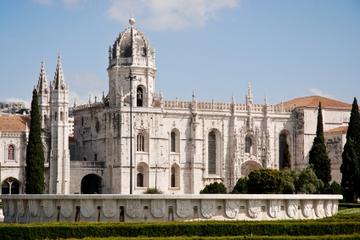 Monastery of St Jerome (Mosteiro dos Jeronimos)
Monastery of St Jerome (Mosteiro dos Jeronimos) Vasco da Gamas discovery of a sea route to India inspired the glorious Monastery of St. Jerome or Mosteiro dos Jerónimos, a UNESCO World Heritage site with an architectural exuberance that trumpets navigational triumph. Work began around 1501, follow
Monastery of St Jerome (Mosteiro dos Jeronimos)
Monastery of St Jerome (Mosteiro dos Jeronimos) Vasco da Gamas discovery of a sea route to India inspired the glorious Monastery of St. Jerome or Mosteiro dos Jerónimos, a UNESCO World Heritage site with an architectural exuberance that trumpets navigational triumph. Work began around 1501, follow
-
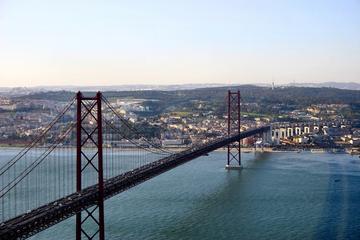 Tagus River
Tagus River Climb to the top of any of Lisbon’s seven hills and you’ll be rewarded with the sight of the Tagus River glistening in the distance. It is the longest river on the Iberian Peninsula, flowing 626 miles (1,007 km) from the Sierra de Albarracín in eastern Spain to empty itself into the At
Tagus River
Tagus River Climb to the top of any of Lisbon’s seven hills and you’ll be rewarded with the sight of the Tagus River glistening in the distance. It is the longest river on the Iberian Peninsula, flowing 626 miles (1,007 km) from the Sierra de Albarracín in eastern Spain to empty itself into the At
-
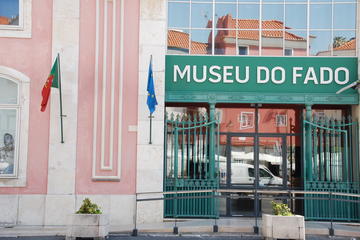 Fado Museum
Fado Museum Fado, a traditional music style popularized in the streets and taverns of Lisbon during the 1800s, is Portugal’s version of the blues. Birthed amid the underclass of the city, fado gradually gained popularity, moving out of seedy taverns and into upscale dance halls and theaters
Fado Museum
Fado Museum Fado, a traditional music style popularized in the streets and taverns of Lisbon during the 1800s, is Portugal’s version of the blues. Birthed amid the underclass of the city, fado gradually gained popularity, moving out of seedy taverns and into upscale dance halls and theaters
-
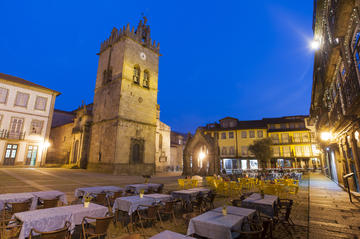 Guimaraes
Guimaraes The city of Guimaraes was originally settled in the 9th century and is widely regarded as being “the cradle of the Portuguese nationality.” It served as center of government for the historic county of Portugal after the Moorish invaders were pushed out by the Kingdom of Galicia in the 10
Guimaraes
Guimaraes The city of Guimaraes was originally settled in the 9th century and is widely regarded as being “the cradle of the Portuguese nationality.” It served as center of government for the historic county of Portugal after the Moorish invaders were pushed out by the Kingdom of Galicia in the 10
-
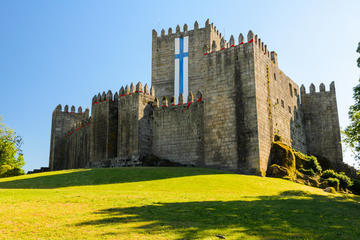 Guimarães Castle (Castelo de Guimarães)
Guimarães Castle (Castelo de Guimarães) Guimaraes Castle is a medieval castle in the city of Guimaraes in the northern part of Portugal. Built in the 10th century to defend against attacks from the Moors and Normans, it was expanded during the early Gothic period of Portuguese architecture. The wa
Guimarães Castle (Castelo de Guimarães)
Guimarães Castle (Castelo de Guimarães) Guimaraes Castle is a medieval castle in the city of Guimaraes in the northern part of Portugal. Built in the 10th century to defend against attacks from the Moors and Normans, it was expanded during the early Gothic period of Portuguese architecture. The wa
-
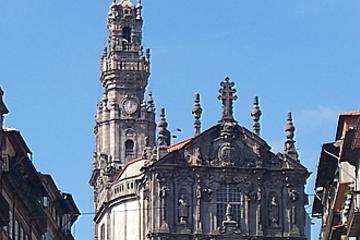 Torre & Igreja dos Clerigos
Torre & Igreja dos Clerigos One of the symbols of Porto is the Torre dos Clerigos, the bell tower adjoining the Clerigos Church, a baroque church built between 1732 and 1750. The church was one of the first Baroque churches in Portugal. Its Baroque adornments reflect the city’s seaside way of life
Torre & Igreja dos Clerigos
Torre & Igreja dos Clerigos One of the symbols of Porto is the Torre dos Clerigos, the bell tower adjoining the Clerigos Church, a baroque church built between 1732 and 1750. The church was one of the first Baroque churches in Portugal. Its Baroque adornments reflect the city’s seaside way of life
-
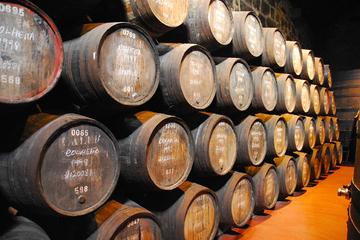 Porto Calem
Porto Calem Founded in 1859 by António Alves Cálem, Porto Calem is one of the most celebrated wineries in the Porto region. It is located in Vila Nova de Gaia, on the south bank of the Duoro River. While modest beginnings saw the winery export to colonies in Brazil through private marine fleets in
Porto Calem
Porto Calem Founded in 1859 by António Alves Cálem, Porto Calem is one of the most celebrated wineries in the Porto region. It is located in Vila Nova de Gaia, on the south bank of the Duoro River. While modest beginnings saw the winery export to colonies in Brazil through private marine fleets in
-
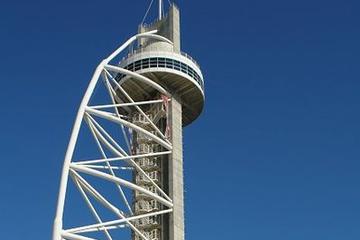 Park of the Nations (Parque das Nações)
Park of the Nations (Parque das Nações) On the northeastern riverfront lies the Parque das Nações. Built for Expo 98, the development includes a huge world-of-its-own aquarium, the Oceanário, plus the Pavilhão do Conhecimento, and a landscaped riverside park with restaurants and bars. Theres some
Park of the Nations (Parque das Nações)
Park of the Nations (Parque das Nações) On the northeastern riverfront lies the Parque das Nações. Built for Expo 98, the development includes a huge world-of-its-own aquarium, the Oceanário, plus the Pavilhão do Conhecimento, and a landscaped riverside park with restaurants and bars. Theres some
-
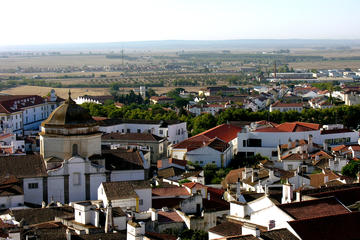 Evora
Evora One of Portugal’s most fascinating destinations, Evora is a city full of historic national treasures that keep any visitor intrigued. From the Roman ruins of the Templo de Diana (Temple of Diana) featuring 14 original Corinthian columns, to the Capela dos Ossos (Bones of Chapel), which is co
Evora
Evora One of Portugal’s most fascinating destinations, Evora is a city full of historic national treasures that keep any visitor intrigued. From the Roman ruins of the Templo de Diana (Temple of Diana) featuring 14 original Corinthian columns, to the Capela dos Ossos (Bones of Chapel), which is co
-
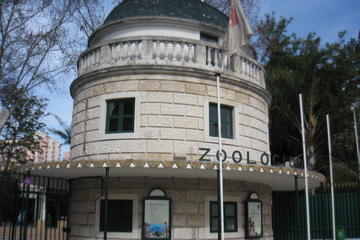 Lisbon Zoo (Jardim Zoológico de Lisboa)
Lisbon Zoo (Jardim Zoológico de Lisboa) Jardim Zoológico, in attractive gardens, has more than 2,000 animals of 300 species. Their theme is nature, animals, and ecology. There are the usual feeding sessions and a childrens farm. The gardens also provide shaded picnic areas. Theres also a dolphin s
Lisbon Zoo (Jardim Zoológico de Lisboa)
Lisbon Zoo (Jardim Zoológico de Lisboa) Jardim Zoológico, in attractive gardens, has more than 2,000 animals of 300 species. Their theme is nature, animals, and ecology. There are the usual feeding sessions and a childrens farm. The gardens also provide shaded picnic areas. Theres also a dolphin s
Total
723 -travel
FirstPage PreviousPage NextPage LastPage CurrentPage:
6/37 20-travel/Page GoTo Page:
 Aveiro
Aveiro In Roman times, Aveiro was known as Aviarium, which in Latin means “gathering of birds” due to the large number of birds inhabiting the city’s lagoon area. Today, Aveiro is known for being one of the largest metropolitan areas in Portugal (when associated with nearby Ílhavo). It’s also know
Aveiro
Aveiro In Roman times, Aveiro was known as Aviarium, which in Latin means “gathering of birds” due to the large number of birds inhabiting the city’s lagoon area. Today, Aveiro is known for being one of the largest metropolitan areas in Portugal (when associated with nearby Ílhavo). It’s also know
 Maritime Museum (Museu de Marinha)
Maritime Museum (Museu de Marinha) Lisbon has a long and proud maritime history. This museum focuses on that long naval history with model ships, nautical instruments and uniforms. Among the armadas of model boats, this museum has gems such as Vasco da Gamas portable wooden altar and the rich, pol
Maritime Museum (Museu de Marinha)
Maritime Museum (Museu de Marinha) Lisbon has a long and proud maritime history. This museum focuses on that long naval history with model ships, nautical instruments and uniforms. Among the armadas of model boats, this museum has gems such as Vasco da Gamas portable wooden altar and the rich, pol
 Oceanário de Lisboa
Oceanário de Lisboa The modern beating heart of Lisbon now lies in the Parque das Nacoes, the brainchild of Spanish architect Santiago Calatrava that was constructed for the 100th World Expo in 1998. Calatrava’s reshaping of the city’s formerly dilapidated waterfront into something resembling a mi
Oceanário de Lisboa
Oceanário de Lisboa The modern beating heart of Lisbon now lies in the Parque das Nacoes, the brainchild of Spanish architect Santiago Calatrava that was constructed for the 100th World Expo in 1998. Calatrava’s reshaping of the city’s formerly dilapidated waterfront into something resembling a mi
 Santana
Santana Santana’s brightly colored A-frame houses, built in a traditional style with natural stone and thatched roofs, make this mountain destination worth the trip any time of year. The rolling wheat and rye fields, dotted with these triangular bungalows, are famous and distinctive sights. Travel
Santana
Santana Santana’s brightly colored A-frame houses, built in a traditional style with natural stone and thatched roofs, make this mountain destination worth the trip any time of year. The rolling wheat and rye fields, dotted with these triangular bungalows, are famous and distinctive sights. Travel
 Alcobaça
Alcobaça Alcobaça is a pleasant town with a jumble of medieval and modern architecture and a largely pedestrianized center, but its main attraction is undoubtedly Portugal’s first monastery, founded here by the country’s first king, Alfonso Henriques, in 1153. Today the magical Cistercian monaster
Alcobaça
Alcobaça Alcobaça is a pleasant town with a jumble of medieval and modern architecture and a largely pedestrianized center, but its main attraction is undoubtedly Portugal’s first monastery, founded here by the country’s first king, Alfonso Henriques, in 1153. Today the magical Cistercian monaster
 Vilamoura
Vilamoura Just 29 km (18 miles) north-west of Faro airport, Vilamoura sits on the Algarve’s Atlantic shoreline and is the region’s classiest purpose-built leisure resort. The town and its four international-level golf courses are a destination for golfers and sailors and the location of world-clas
Vilamoura
Vilamoura Just 29 km (18 miles) north-west of Faro airport, Vilamoura sits on the Algarve’s Atlantic shoreline and is the region’s classiest purpose-built leisure resort. The town and its four international-level golf courses are a destination for golfers and sailors and the location of world-clas
 Sagres
Sagres Twenty-one miles west of Lagos, the whitewashed village of Sagres is popular with families looking for a laidback holiday spot near the Algarve’s famous beaches. Backpackers, surfers, and divers also come to Sagres to holiday. Most of the action takes place around the town square, where the
Sagres
Sagres Twenty-one miles west of Lagos, the whitewashed village of Sagres is popular with families looking for a laidback holiday spot near the Algarve’s famous beaches. Backpackers, surfers, and divers also come to Sagres to holiday. Most of the action takes place around the town square, where the
 Ria Formosa Natural Park
Ria Formosa Natural Park Like Porto’s Parque Nacional da Peneda-Gerês, the Parque Natural da Ria Formosa is a Portuguese national treasure created for the preservation of the the Algarve’s unique marshland and its flora and fauna. It encompasses a large lagoon area hugging almost 60 km (37 mi) of
Ria Formosa Natural Park
Ria Formosa Natural Park Like Porto’s Parque Nacional da Peneda-Gerês, the Parque Natural da Ria Formosa is a Portuguese national treasure created for the preservation of the the Algarve’s unique marshland and its flora and fauna. It encompasses a large lagoon area hugging almost 60 km (37 mi) of
 Quarteira
Quarteira With roots going back to Roman times, Quarteira was for many years a backwater fishing village, but today it is a buzzing seaside resort with the restaurant-lined promenade of Avenida Infante de Sagres backing the Atlantic Ocean. Primarily a family resort and very popular with Portuguese
Quarteira
Quarteira With roots going back to Roman times, Quarteira was for many years a backwater fishing village, but today it is a buzzing seaside resort with the restaurant-lined promenade of Avenida Infante de Sagres backing the Atlantic Ocean. Primarily a family resort and very popular with Portuguese
 25th of April Bridge
25th of April Bridge This massive suspension bridge is an icon of Lisbon, connecting the city to the Almada area over the narrowest section of the River Tagus. Its color, size and structure draw close comparison to the Golden Gate Bridge of San Francisco, California, but the bridge was actually mo
25th of April Bridge
25th of April Bridge This massive suspension bridge is an icon of Lisbon, connecting the city to the Almada area over the narrowest section of the River Tagus. Its color, size and structure draw close comparison to the Golden Gate Bridge of San Francisco, California, but the bridge was actually mo
 Monastery of St Jerome (Mosteiro dos Jeronimos)
Monastery of St Jerome (Mosteiro dos Jeronimos) Vasco da Gamas discovery of a sea route to India inspired the glorious Monastery of St. Jerome or Mosteiro dos Jerónimos, a UNESCO World Heritage site with an architectural exuberance that trumpets navigational triumph. Work began around 1501, follow
Monastery of St Jerome (Mosteiro dos Jeronimos)
Monastery of St Jerome (Mosteiro dos Jeronimos) Vasco da Gamas discovery of a sea route to India inspired the glorious Monastery of St. Jerome or Mosteiro dos Jerónimos, a UNESCO World Heritage site with an architectural exuberance that trumpets navigational triumph. Work began around 1501, follow
 Tagus River
Tagus River Climb to the top of any of Lisbon’s seven hills and you’ll be rewarded with the sight of the Tagus River glistening in the distance. It is the longest river on the Iberian Peninsula, flowing 626 miles (1,007 km) from the Sierra de Albarracín in eastern Spain to empty itself into the At
Tagus River
Tagus River Climb to the top of any of Lisbon’s seven hills and you’ll be rewarded with the sight of the Tagus River glistening in the distance. It is the longest river on the Iberian Peninsula, flowing 626 miles (1,007 km) from the Sierra de Albarracín in eastern Spain to empty itself into the At
 Fado Museum
Fado Museum Fado, a traditional music style popularized in the streets and taverns of Lisbon during the 1800s, is Portugal’s version of the blues. Birthed amid the underclass of the city, fado gradually gained popularity, moving out of seedy taverns and into upscale dance halls and theaters
Fado Museum
Fado Museum Fado, a traditional music style popularized in the streets and taverns of Lisbon during the 1800s, is Portugal’s version of the blues. Birthed amid the underclass of the city, fado gradually gained popularity, moving out of seedy taverns and into upscale dance halls and theaters
 Guimaraes
Guimaraes The city of Guimaraes was originally settled in the 9th century and is widely regarded as being “the cradle of the Portuguese nationality.” It served as center of government for the historic county of Portugal after the Moorish invaders were pushed out by the Kingdom of Galicia in the 10
Guimaraes
Guimaraes The city of Guimaraes was originally settled in the 9th century and is widely regarded as being “the cradle of the Portuguese nationality.” It served as center of government for the historic county of Portugal after the Moorish invaders were pushed out by the Kingdom of Galicia in the 10
 Guimarães Castle (Castelo de Guimarães)
Guimarães Castle (Castelo de Guimarães) Guimaraes Castle is a medieval castle in the city of Guimaraes in the northern part of Portugal. Built in the 10th century to defend against attacks from the Moors and Normans, it was expanded during the early Gothic period of Portuguese architecture. The wa
Guimarães Castle (Castelo de Guimarães)
Guimarães Castle (Castelo de Guimarães) Guimaraes Castle is a medieval castle in the city of Guimaraes in the northern part of Portugal. Built in the 10th century to defend against attacks from the Moors and Normans, it was expanded during the early Gothic period of Portuguese architecture. The wa
 Torre & Igreja dos Clerigos
Torre & Igreja dos Clerigos One of the symbols of Porto is the Torre dos Clerigos, the bell tower adjoining the Clerigos Church, a baroque church built between 1732 and 1750. The church was one of the first Baroque churches in Portugal. Its Baroque adornments reflect the city’s seaside way of life
Torre & Igreja dos Clerigos
Torre & Igreja dos Clerigos One of the symbols of Porto is the Torre dos Clerigos, the bell tower adjoining the Clerigos Church, a baroque church built between 1732 and 1750. The church was one of the first Baroque churches in Portugal. Its Baroque adornments reflect the city’s seaside way of life
 Porto Calem
Porto Calem Founded in 1859 by António Alves Cálem, Porto Calem is one of the most celebrated wineries in the Porto region. It is located in Vila Nova de Gaia, on the south bank of the Duoro River. While modest beginnings saw the winery export to colonies in Brazil through private marine fleets in
Porto Calem
Porto Calem Founded in 1859 by António Alves Cálem, Porto Calem is one of the most celebrated wineries in the Porto region. It is located in Vila Nova de Gaia, on the south bank of the Duoro River. While modest beginnings saw the winery export to colonies in Brazil through private marine fleets in
 Park of the Nations (Parque das Nações)
Park of the Nations (Parque das Nações) On the northeastern riverfront lies the Parque das Nações. Built for Expo 98, the development includes a huge world-of-its-own aquarium, the Oceanário, plus the Pavilhão do Conhecimento, and a landscaped riverside park with restaurants and bars. Theres some
Park of the Nations (Parque das Nações)
Park of the Nations (Parque das Nações) On the northeastern riverfront lies the Parque das Nações. Built for Expo 98, the development includes a huge world-of-its-own aquarium, the Oceanário, plus the Pavilhão do Conhecimento, and a landscaped riverside park with restaurants and bars. Theres some
 Evora
Evora One of Portugal’s most fascinating destinations, Evora is a city full of historic national treasures that keep any visitor intrigued. From the Roman ruins of the Templo de Diana (Temple of Diana) featuring 14 original Corinthian columns, to the Capela dos Ossos (Bones of Chapel), which is co
Evora
Evora One of Portugal’s most fascinating destinations, Evora is a city full of historic national treasures that keep any visitor intrigued. From the Roman ruins of the Templo de Diana (Temple of Diana) featuring 14 original Corinthian columns, to the Capela dos Ossos (Bones of Chapel), which is co
 Lisbon Zoo (Jardim Zoológico de Lisboa)
Lisbon Zoo (Jardim Zoológico de Lisboa) Jardim Zoológico, in attractive gardens, has more than 2,000 animals of 300 species. Their theme is nature, animals, and ecology. There are the usual feeding sessions and a childrens farm. The gardens also provide shaded picnic areas. Theres also a dolphin s
Lisbon Zoo (Jardim Zoológico de Lisboa)
Lisbon Zoo (Jardim Zoológico de Lisboa) Jardim Zoológico, in attractive gardens, has more than 2,000 animals of 300 species. Their theme is nature, animals, and ecology. There are the usual feeding sessions and a childrens farm. The gardens also provide shaded picnic areas. Theres also a dolphin s